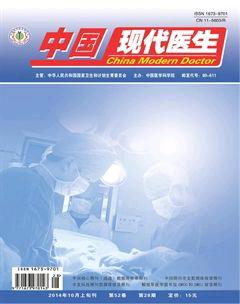2010~2013年239株粪肠球菌临床耐药特征
贝华锋+茅国峰
[摘要] 目的 探讨本院近三年粪肠球菌临床分布及耐药性特征,为临床用药提供参考。 方法 选取近三年临床分离出的粪肠球菌239株,分析其临床分布特征,并做常规抗生素敏感性试验,用whonet5.4软件进行统计学分析。结果 粪肠球菌大多来源于肝胆外科、泌尿外科的尿液、胆汁和引流液标本;对喹努普汀/达福普汀耐药率为100%,对四环素和红霉素耐药率均为53.14%,呋喃妥因对粪肠球菌敏感性较高,为95.82%;粪肠球菌对替加环素、替考拉宁和万古霉素全敏感。结论 加强药敏试验,定期监测临床耐药现象,对指导临床用药具有重要意义。
[关键词] 粪肠球菌;耐药性;抗生素;药敏试验
[中图分类号] R446.5 [文献标识码] B [文章编号] 1673-9701(2014)28-0063-03
肠球菌属为条件致病性菌,可造成人体多种组织器官感染,为人体肠道内正常寄生菌群,异味寄生可引起呼吸道、泌尿道及败血症等一系列感染病症。近年来发现肠球菌引起的院内感染现象日益严重,且对常规药物耐药性日益严重,其中最常见的为粪肠球菌[1,2],容易被忽视,为了解本院粪肠球菌感染情况及耐药率,选取近三年来临床分离的粪肠球菌为研究对象,分析其临床分布及感染情况,同时监测其对各种常见抗生素耐药率及敏感性,为临床医师选择抗生素做参考。
1 材料与方法
1.1 标本来源
收集中医院2010~2013年三年临床科室分离的239株粪肠球菌,操作规程按卫生部标准进行。
1.2 分析方法
采用法国全自动梅里埃微生物鉴定仪分离鉴定菌株,纸片扩散法(K-B法)进行药敏实验,根据CLSI规定的标准判定结果[3]。
1.3 药敏纸片
药敏纸片为喹努普汀/达福普汀、四环素、红霉素、高水平庆大霉素、高水平链霉素、氨苄西林、青霉素G、环丙沙星、左旋氧氟沙星、莫西沙星、呋喃妥因、替加环素、替考拉宁和万古霉素。
1.4 统计学处理
Whonet5.4软件进行统计学分析。
2 结果
2.1 标本来源
本院分离的239株粪肠球菌主要取自胆汁、尿液及引流液中,占80%以上,其中尿液97例,胆汁86例,见表1。
2.2 科室分布
肝胆外科和泌尿外科分别分离出粪肠球菌108株和63株,占大多数,其余各科室分离菌落数较少,见表2 。
2.3 药敏试验
药敏结果显示粪肠球菌对喹努普汀/达福普汀耐药率为100%,对四环素和红霉素耐药率均为53.14%,呋喃妥因对粪肠球菌敏感性较高,为95.82;对青霉素G、氨苄西林和莫西沙星等敏感性亦较高,为80%左右,粪肠球菌对替加环素、替考拉宁和万古霉素全敏感(表3)。
3 讨论
肠球菌存在于人及动物肠道内,属于正常菌群,最初在肠道及盆腔感染中被发现,在院内感染致病菌中仅次于葡萄球菌。肠球菌能够引起一系列感染病灶,如泌尿系统感染、呼吸系统感染及败血症等感染症状。其中最重要的代表是粪肠球菌,属于条件致病菌。近几年来,由于应用侵入性治疗,免疫抑制剂的广泛使用以及不合理应用抗菌药物等若干原因,导致粪肠球菌耐药现象日益严峻,应受到临床重视。
本文对临床分离出的239株粪肠球菌统计分析表明,粪肠球菌大多数来自于胆汁、尿液及引流液等标本中。据报道院内尿路感染中大肠杆菌居首,肠球菌以16%的比例位居第二,导致这种现象的原因主要与导尿管的留置、医疗器械的操作以及异常的尿路结构相关,如肾盂肾炎及膀胱炎等,也有少数为肾周脓肿[4,5]。与廖国林等[6]报道结果一致,但与刘媚娜等[7]结果具有一定差异,这与医院的科室结构、床位配置、病种构成、标本来源等不同有关。对于本院而言,肝胆外科和泌尿外科分别分离出粪肠球菌108株和63株,占大多数。
近年来由于免疫抑制剂和广谱抗菌药物使用,出现了耐高浓度氨基糖苷类药物肠球菌属(HLAR)[8-10]和耐万古霉素肠球菌(VRE)[11,12]。氨基糖苷类抗生素对于细菌的作用主要是抑制细菌蛋白质的合成,研究表明,氨基糖苷类抗生素妨碍初始复合物的合成,通过影响细菌蛋白质合成全过程,诱导细菌合成错误蛋白以及阻抑已合成蛋白的释放,从而导致细菌死亡。耐高浓度氨基糖苷类药物肠球菌属产生的质粒介导的氨基糖苷类修饰酶[如乙酰转移酶(AAC)、磷酸转移酶(APH)、核苷转移酶(ANT)]使氨基糖苷类抗菌药物氨基乙酰化、羟基磷酸化和羟基核苷化,不能再与细菌核糖体结合,使得该类细菌与细胞壁合成药物的联合用药的协同作用消失[13-16]。本院粪肠球菌药敏结果显示粪肠球菌对喹努普汀/达福普汀耐药率为100%,对四环素和红霉素耐药率均为53.14%。相关文献[17-19]研究表明肠球菌对青霉素敏感性较差,主要机制为细菌产生一种特殊的青霉素结合蛋白(PBP5),后者与青霉素的亲和力减低,从而导致耐药[20,21],本研究显示粪肠球菌对青霉素G敏感性亦较高,提示本院尚未出现较高的青霉素耐药粪肠球菌,肠球菌属通常存在于人体肠道和女性生殖道中,而且常常存在于环境中,这类细菌可造成感染。万古霉素常常作为治疗肠球菌属感染的最后有效抗菌药物,某些情况下,肠球菌属对万古霉素产生耐药,这类细菌称为耐万古霉素肠球菌(VRE),大多数的VRE感染通常发生在医院内[22,23]。本院粪肠球菌对氨基糖苷类药物庆大霉素和链霉素耐药率亦较低,敏感性为万古霉素100%,尚未出现耐万古霉素肠球菌(VRE)菌株,表明肠球菌中粪肠球菌耐药性普遍较屎肠球菌缓和,与相关文献报道一致[22,23],但临床必须严格按照实验室检测的耐药情况进行用药,防止耐药现象加重。
从本文粪肠球菌耐药分析得出,目前我院分离的粪肠球菌耐药现象控制较好,常用药物亦具有较强的抗菌作用。临床上应对产菌株进行监测,临床医师应避免经验用药,要通过耐药性检测和药敏试验为其提供合理选择抗生素治疗的直接依据,以达到增加治愈率,减少耐药率的目的,控制耐药菌株的播散和流行。endprint
[参考文献]
[1] Arias CA,Murray BE. The rise of the Enterococcus:beyond vancomycin resistance[J]. Nat Rev Microbiol,2012,10(4):266-278.
[2] 胡志东,王金良. 肠球菌耐药性的研究进展[J]. 国际流行病学传染病学志,2007,34(4):284.
[3] 郭玲娇,李招云,张颖,等. 鲍氏不动杆菌感染及耐药性分析[J]. 中华医院感染学杂志,2007,17(2):216-217.
[4] Matsumoto T,Hamasuna R,Ishikawa K,et al. Sensitivities of major causative organisms isolated from patients with acute uncomplicated cystitis against various antibacterial agents:results of subanalysis based on the presence of menopause[J]. J Infect Chemother,2012,18(4):597-607.
[5] Cai T,Mazzoli S,Mondaini N,et al. The role of asymptomatic bacteriuria in young women with recurrent urinary tract infections:to treat or not to treat?[J]. Clin Infect Dis,2012,55(6):771-777.
[6] 廖国林,刘建,李芳,等. 肠球菌属医院感染分布及耐药性分析[J]. 中华医院感染学杂志,2009,19(13):1735-1736.
[7] 刘媚娜,程水兵,徐春泉,等. 屎肠球菌和粪肠球菌的耐药性分析[J]. 中国卫生检验杂志,2010,20(5):1165-1166.
[8] Kozuszko S,Bialucha A,Bogiel T,et al. High level of aminoglycoside resistanceamong Enterococcus faecalis and Enterococcusfaecium strains[J]. Med Dosw Mikrobiol,2011, 63(2):105-113.
[9] Sibel AK,Koroglu M,Muharrem AK. The evaluation of antimicrobial susceptibility of urine enterococci with the Vitek 2 automated system in eastern Turkey[J]. Southeast Asian J Trop Med Public Health,2012,43(4):986-991.
[10] Aleksandrowicz. The incidence of high-level aminoglicoside and high-level beta-lactam resistance among enterococcal strains of various origin[J]. Med Dosw Mikrobiol,2012,64(1):11-18.
[11] Linden PK. Optimizing therapy for vancomycin-resistant enterococci(VRE)[J]. Semin Respir Crit Care Med,2007,28(6):632-645.
[12] Anderson NW,Buchan BW,Young CL,et al. Multicenter clinical evaluation of VRE select agar for identification of vancomycin-resistant Enterococcus faecalisand Enterococcus faecium[J]. J Clin Microbiol,2013,51(8):2758-2760.
[13] Parameswarappa J,Basavaraj VP,Basavaraj CM. Isolation,identification,and antibiogram of enterococci isolated from patients with urinary tract infection[J]. Ann Afr Med,2013,12(3):176-181.
[14] Thakuria B,Lahon K. The beta lactam antibiotics as an empirical therapy in a developing country:an update on their current status and recommendations to counter the resistance against them[J]. J Clin Diagn Res,2013,7(6):1207-1214.
[15] Czogala W,Gozdzik J,Czogala M,et al. Evaluation of colonization by multidrug-resistant organisms and infections' frequency in chronically and incurably ill children under care of the Cracow Children's Hospice of Father J. Tischner[J]. Przegl Lek,2010,67(1):40-44.endprint
[16] Mendiratta DK,Kaur H,Deotale V,et al. Status of high level aminoglycoside resistant Enterococcus faecium and Enterococcus faecalis in a rural hospital of central India[J]. Indian J Med Microbiol,2008,26(4):369-371.
[17] Cercenado E. Enterococcus:phenotype and genotype resistance and epidemiology in Spain[J]. Enferm Infecc Microbiol Clin,2011,29(5):59-65.
[18] Schwaiger K,Bauer J,Hormansdorfer S,et al. Presence of the resistance genes vanC1 and pbp5 in phenotypically vancomycin and ampicillin susceptible Enterococcus faecalis[J]. Microb Drug Resist,2012,18(4):434-439.
[19] Hanchi H,Hammami R,Kourda R,et al. Bacteriocinogenic properties and in vitro probiotic potential of Enterococci from Tunisian dairy products[J]. Arch Microbiol, 2014,196(5):331-344.
[20] Leimanis S,Hoyez N,Hubert S,et al. PBP5 complementation of a PBP3 deficiency in Enterococcus hirae[J]. J Bacteriol,2006,188(17):6298-6307.
[21] López M,Tenorio C,Del Campo R. Characterization of the mechanisms of fluoroquinolone resistance in vancomycin-resistant Enterococci of different origins[J]. J Chemother,2011,23(2):87-91.
[22] Eerdunbayaer EY,Orabi MA,Aoyama H,et al. Structures of two new flavonoids and effects of licorice phenolics on vancomycin-resistantent Enterococcus species[J]. Mole-cules,2014,19(4):3883-3897.
[23] Jovanovic M,Milosevic B,Dulovic O,et al. Molecular characterization of vancomycin-resistant Enterococci in Serbia:intensive care unit as the source[J]. Acta Microbiol Immunol Hung,2013,60(4):433-446.
(收稿日期:2014-03-11)endprint
[16] Mendiratta DK,Kaur H,Deotale V,et al. Status of high level aminoglycoside resistant Enterococcus faecium and Enterococcus faecalis in a rural hospital of central India[J]. Indian J Med Microbiol,2008,26(4):369-371.
[17] Cercenado E. Enterococcus:phenotype and genotype resistance and epidemiology in Spain[J]. Enferm Infecc Microbiol Clin,2011,29(5):59-65.
[18] Schwaiger K,Bauer J,Hormansdorfer S,et al. Presence of the resistance genes vanC1 and pbp5 in phenotypically vancomycin and ampicillin susceptible Enterococcus faecalis[J]. Microb Drug Resist,2012,18(4):434-439.
[19] Hanchi H,Hammami R,Kourda R,et al. Bacteriocinogenic properties and in vitro probiotic potential of Enterococci from Tunisian dairy products[J]. Arch Microbiol, 2014,196(5):331-344.
[20] Leimanis S,Hoyez N,Hubert S,et al. PBP5 complementation of a PBP3 deficiency in Enterococcus hirae[J]. J Bacteriol,2006,188(17):6298-6307.
[21] López M,Tenorio C,Del Campo R. Characterization of the mechanisms of fluoroquinolone resistance in vancomycin-resistant Enterococci of different origins[J]. J Chemother,2011,23(2):87-91.
[22] Eerdunbayaer EY,Orabi MA,Aoyama H,et al. Structures of two new flavonoids and effects of licorice phenolics on vancomycin-resistantent Enterococcus species[J]. Mole-cules,2014,19(4):3883-3897.
[23] Jovanovic M,Milosevic B,Dulovic O,et al. Molecular characterization of vancomycin-resistant Enterococci in Serbia:intensive care unit as the source[J]. Acta Microbiol Immunol Hung,2013,60(4):433-446.
(收稿日期:2014-03-11)endprint
[16] Mendiratta DK,Kaur H,Deotale V,et al. Status of high level aminoglycoside resistant Enterococcus faecium and Enterococcus faecalis in a rural hospital of central India[J]. Indian J Med Microbiol,2008,26(4):369-371.
[17] Cercenado E. Enterococcus:phenotype and genotype resistance and epidemiology in Spain[J]. Enferm Infecc Microbiol Clin,2011,29(5):59-65.
[18] Schwaiger K,Bauer J,Hormansdorfer S,et al. Presence of the resistance genes vanC1 and pbp5 in phenotypically vancomycin and ampicillin susceptible Enterococcus faecalis[J]. Microb Drug Resist,2012,18(4):434-439.
[19] Hanchi H,Hammami R,Kourda R,et al. Bacteriocinogenic properties and in vitro probiotic potential of Enterococci from Tunisian dairy products[J]. Arch Microbiol, 2014,196(5):331-344.
[20] Leimanis S,Hoyez N,Hubert S,et al. PBP5 complementation of a PBP3 deficiency in Enterococcus hirae[J]. J Bacteriol,2006,188(17):6298-6307.
[21] López M,Tenorio C,Del Campo R. Characterization of the mechanisms of fluoroquinolone resistance in vancomycin-resistant Enterococci of different origins[J]. J Chemother,2011,23(2):87-91.
[22] Eerdunbayaer EY,Orabi MA,Aoyama H,et al. Structures of two new flavonoids and effects of licorice phenolics on vancomycin-resistantent Enterococcus species[J]. Mole-cules,2014,19(4):3883-3897.
[23] Jovanovic M,Milosevic B,Dulovic O,et al. Molecular characterization of vancomycin-resistant Enterococci in Serbia:intensive care unit as the source[J]. Acta Microbiol Immunol Hung,2013,60(4):433-446.
(收稿日期:2014-03-11)endprint

